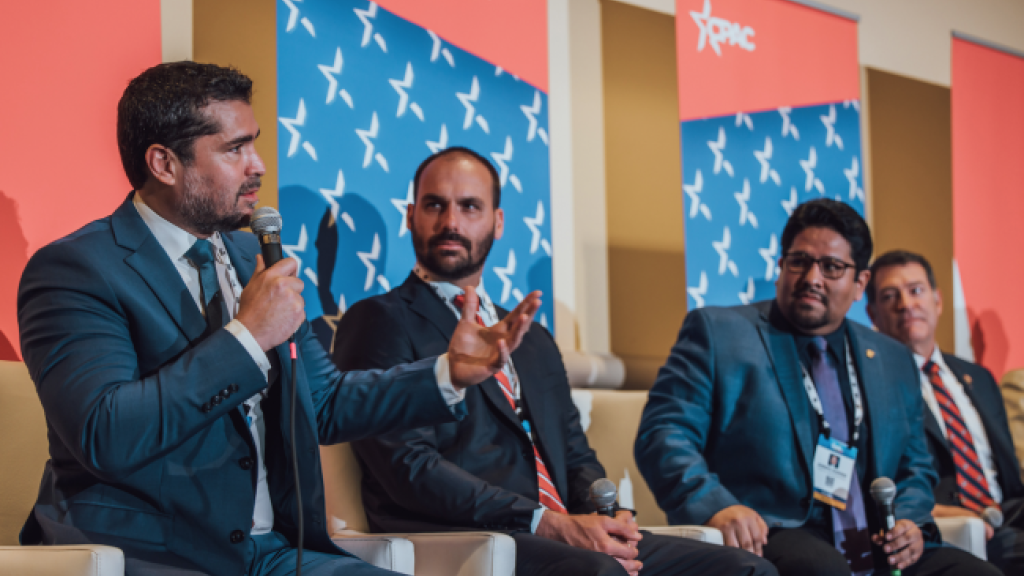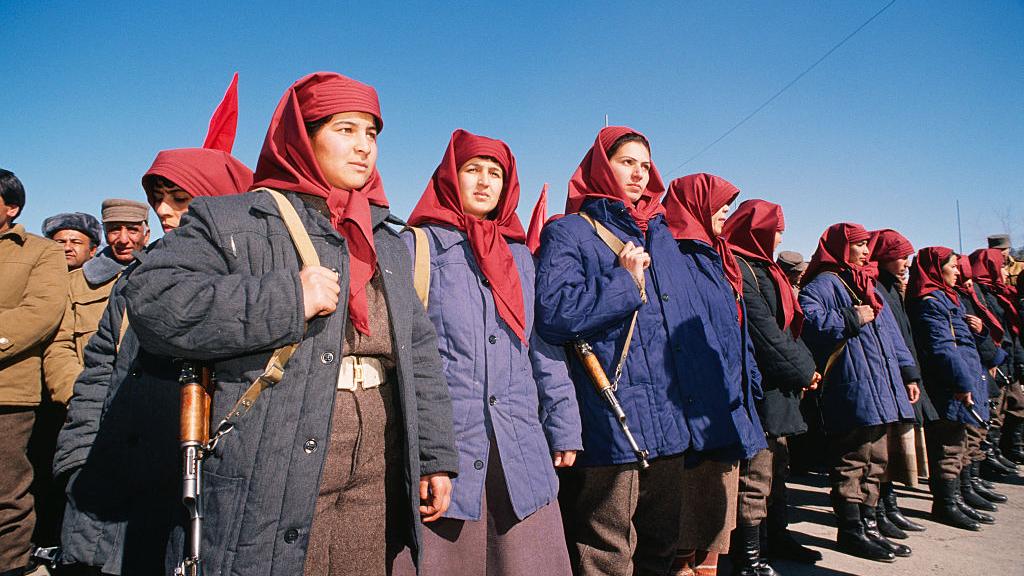The head of MomsRising said that "it would be mean-spirited and shameful for Congress to cut the SNAP benefits moms and families rely on; and it also would be damaging to our economy."

People shop for food in a Brooklyn neighborhood in New York City on October 16, 2023.
(Photo: Spencer Platt/Getty Images)
JESSICA CORBETT
May 17, 2024
Echoing early May criticism of U.S. House Republicans' blueprint for the next Farm Bill, anti-hunger and green groups on Friday fiercely condemned the GOP's discussion draft text of the Farm, Food, and National Security Act of 2024.
Released by U.S. House Committee on Agriculture Chair Glenn "GT" Thompson (R-Pa.), the draft is competing with a Democratic proposal—Senate Agriculture, Nutrition, and Forestry Committee Chair Debbie Stabenow's (D-Mich.) Rural Prosperity and Food Security Act.
While Thomspon claimed that his bill "is the product of extensive feedback from stakeholders and all members of the House, and is responsive to the needs of farm country through the incorporation of hundreds of bipartisan policies," Rep. David Scott (D-Ga.), the panel's ranking member, said that the draft "confirms my worst fears."
"House Republicans plan to pay for the farm bill by taking food out of the mouths of America's hungry children, restricting farmers from receiving the climate-smart conservation funding they so desperately need, and barring the USDA from providing financial assistance to farmers in times of crisis," he warned, referring to the U.S. Department of Agriculture.
The economic impact of the Supplemental Nutrition Assistance Program (SNAP) cuts alone "would be staggering," Scott emphasized. "A $27 billion reduction in food purchasing power would not only increase hunger, but it would also reduce demand for jobs in the agriculture, transportation, manufacturing, and grocery sectors."
Leaders at advocacy groups on Friday similarly slammed the Republican bill. Ty Jones Cox, vice president for food assistance at the Center on Budget and Policy Priorities, reiterated her previous condemnation of GOP attempts to cut the benefits of hungry families, saying that "this is unacceptable; Congress should reject it."
"Every SNAP participant would receive less to buy groceries in future years than they would under current law, putting a healthy diet out of reach for millions of people. This would be the largest cut to SNAP since 1996 if enacted and these cuts would grow even deeper over time," Jones Cox explained, debunking Thompson's description of the changes.
"And the cut to future SNAP benefits isn't the only harmful policy in this bill. For example, it would allow states to outsource SNAP administration to private contractors. But prior privatization efforts delayed benefits for people in need, worsened errors, and increased costs," she continued. "Congress should reject Chair Thompson's harmful proposal and instead work to pass a farm bill that truly protects and strengthens SNAP."
Kristin Rowe-Finkbeiner, executive director and CEO of MomsRising, argued that "at this time when skyrocketing food prices have increased hunger and food insecurity, forcing tens of millions of U.S. families to make impossible choices between food and other essentials, it would be mean-spirited and shameful for Congress to cut the SNAP benefits moms and families rely on; and it also would be damaging to our economy."
Describing the benefits, formerly called food stamps, as "the nation's first line of defense against hunger," Rowe-Finkbeiner highlighted that "more than 42 million people count on SNAP benefits each month and nearly four in five of them are children, seniors, people with disabilities, or veterans."
"In contrast, the bipartisan Senate Farm Bill—the Rural Prosperity and Food Security Act—aids farmers and treats hunger in America as the emergency it is," she noted. "It is a bold bill that would protect SNAP benefits and increase access to this essential program for groups that have long been excluded, reducing barriers to participation for older adults, military families, some college students, and others. It is an easy choice. Without question, the Senate Farm Bill is the version that should become law."
The GOP's efforts to restrict food assistance aren't limited to the United States, as Gina Cummings, Oxfam vice president for advocacy, alliances, and policy, pointed out Friday, declaring that "at a time when over 281 million people are suffering from acute hunger, any proposal to undercut crucial international food assistance programs is damaging."
As Cummings detailed:
The resilience-building programs housed in Food for Peace are vital to preparing frontline communities for future shocks that could impact their food security—whether it be from climate change, conflict, or economic downturns.
Oxfam has raised concerns about the American Farmers Feed the World Act, which is where many of the cuts to Food for Peace originate from—since its introduction last summer. The bill has proposed gutting funding for resilience-building activities that ensure communities can build up their local markets, withstand the next drought, flood, or conflict, and not go hungry. The House Farm Bill as it is currently written includes some of the most concerning provisions of the bill and would render these vital interventions inoperable, resulting in as many as 3 million fewer people being reached by these programs based on their current scale.
The House must reject the provisions of the American Farmers Feed the World Act included in the House Farm Bill draft as the bill goes for markup. The inclusion of such provisions is a threat to global food security and a shift towards a less-efficient model of international aid by the United States.
The AFL-CIO said on social media that it "strongly opposes" the Republican proposal, adding: "Families rely on Food for Peace—and also SNAP, SNAP's Thrifty Food Plan, and other federal nutrition and food security programs. We cannot support making harmful policy changes or funding cuts to any of them."
In addition to calling out the GOP for trying to leave more people hungry, advocates denounced Republican efforts to gut climate-friendly requirements from the Inflation Reduction Act and enact the Ending Agricultural Trade Suppression (EATS) Act.
"The Farm Bill is a seminal opportunity to reform our food and agriculture sector away from factory farms and corporate greed," said Food & Water Watch managing director of policy and litigation Mitch Jones. "Instead, House Republicans want to double down."
"Some of leadership's more dangerous proposals would take us backwards on animal welfare, and climate-smart agriculture—both the EATS Act and support for factory farm biogas must be dead on arrival," he asserted. "It's time Congress put the culture wars aside and got back to work on a Farm Bill that puts consumers, farmers, and the environment above politicking and Big Ag handouts."
Brett Hartl, government affairs director at the Center for Biological Diversity, said that "weakening safeguards that protect people from pesticides, slashing protections for endangered species, and recklessly expanding industrial logging should have no place in the Farm Bill."
"It's unfortunate that chairman Thompson has put forward such a destructive farm bill to appease the most fringe members of Congress," Hartl added. "This bill can't pass the House and it's a waste of everyone's time."
In a joint statement released Friday after a meeting with House Minority Leader Hakeem Jeffries (D-N.Y.) and Democrats on Thompson's panel, Scott and Statenow stressed that members of their party are "committed to passing a strong, bipartisan Farm Bill that strengthens the farm and family safety nets and invests in our rural communities."
"America's farmers, families, workers, and rural communities deserve the certainty of a five-year Farm Bill, and everyone knows it must be bipartisan to pass," the pair said, blasting divisive GOP proposals. "Democrats remain ready and willing to work with Republicans on a truly bipartisan Farm Bill to keep farmers farming, families fed, and rural communities strong."






